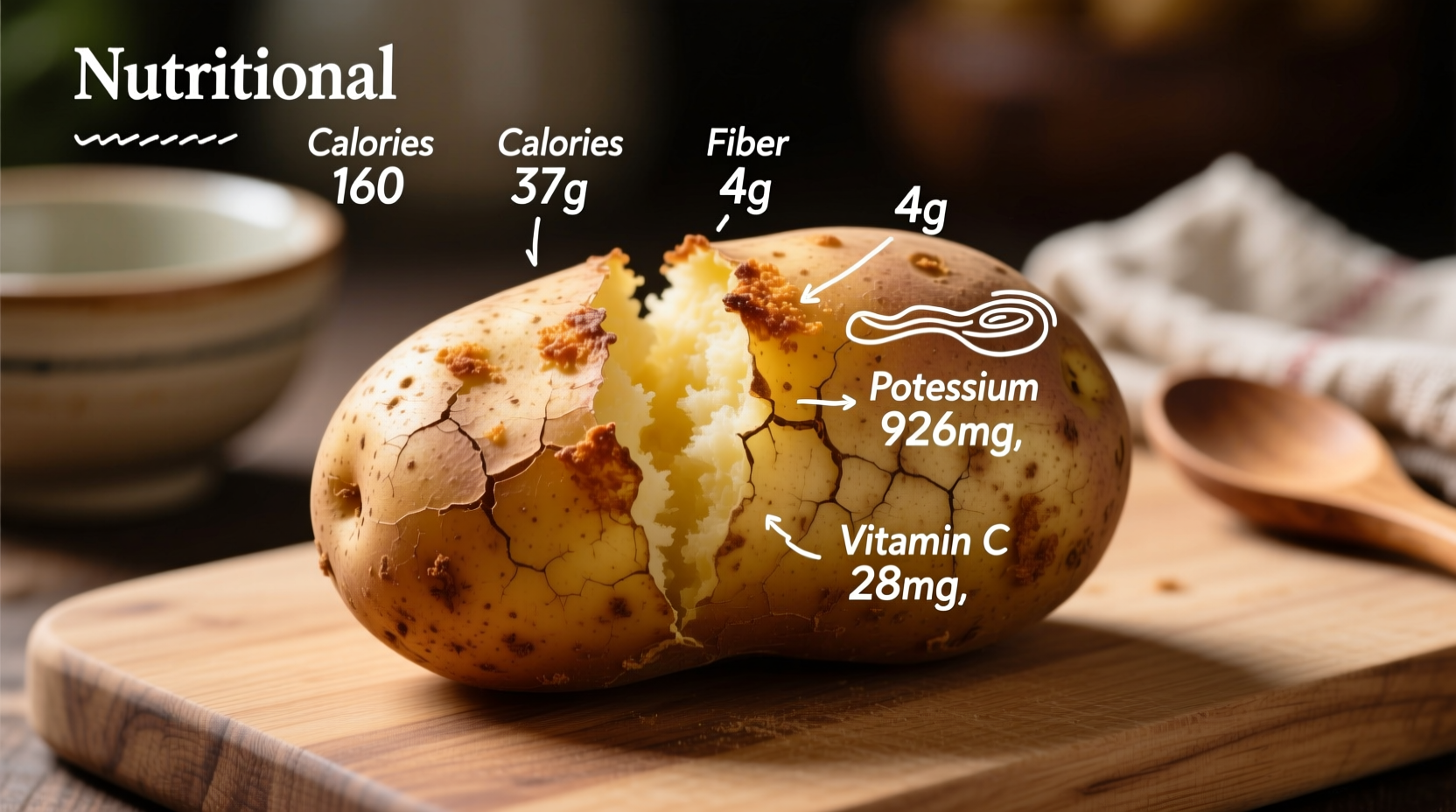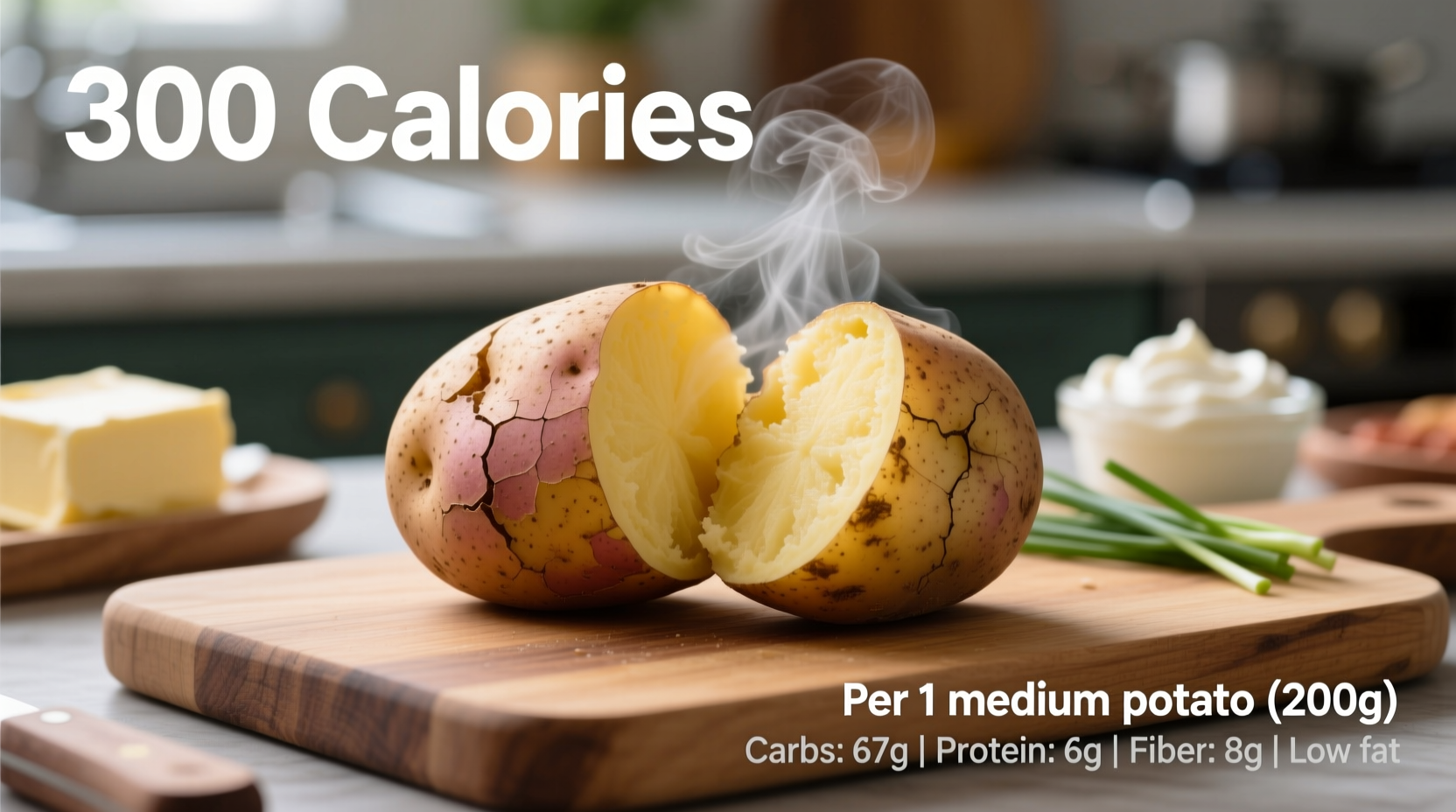Understanding baked potato calories is crucial for anyone tracking their nutritional intake. Whether you're managing weight, fueling athletic performance, or simply making informed food choices, knowing the precise calorie content and nutritional profile helps you incorporate this versatile vegetable wisely into your meal plan.
Exact Calorie Counts by Size
The calorie content of baked potatoes varies significantly based on size. Using data from the USDA FoodData Central database, here's an accurate breakdown of calories in baked potatoes with skin:
| Size Category | Weight (grams) | Calories | Carbohydrates | Fiber |
|---|---|---|---|---|
| Small (2" diameter) | 138g | 129 | 29.6g | 3.4g |
| Medium (3" diameter) | 173g | 161 | 36.6g | 4.3g |
| Large (3.5" diameter) | 276g | 257 | 58.7g | 6.9g |
| Jumbo (4"+ diameter) | 369g | 345 | 78.5g | 9.2g |
This nutritional fact comparison table, verified through the USDA's comprehensive food composition database, shows why portion control matters when tracking calories in baked potatoes. The data confirms that potatoes are naturally fat-free and provide substantial fiber, which contributes to their satiating quality despite moderate carbohydrate content.
How Preparation Affects Calorie Content
Many people wonder whether baking method impacts calorie count. The good news is that the cooking process itself doesn't add calories to plain potatoes. However, these preparation factors significantly affect the final nutritional profile:
- Skin inclusion: Leaving the skin on adds approximately 2g of additional fiber and minimal extra calories while preserving nutrients concentrated near the surface
- Cooking temperature: Higher temperatures (400°F+) create a drier texture but don't alter calorie content
- Cooking time: Longer baking reduces water content slightly, concentrating nutrients but not significantly changing calorie density
- Resting time: Allowing potatoes to rest for 5-10 minutes after baking helps redistribute moisture for more consistent texture

Topping Impact on Total Calories
The real calorie variable comes from toppings. A plain baked potato transforms dramatically with additions. Here's how common toppings affect your final calorie count:
- 2 tablespoons sour cream: +52 calories
- 1 tablespoon butter: +102 calories
- ¼ cup shredded cheddar cheese: +114 calories
- 2 tablespoons bacon bits: +26 calories
- 2 tablespoons plain Greek yogurt: +20 calories
- 2 tablespoons salsa: +10 calories
- 1 tablespoon olive oil: +119 calories
For those following specific dietary patterns, understanding these topping effects is essential. Weight loss seekers might opt for Greek yogurt and herbs instead of traditional high-calorie toppings, while athletes might add a small amount of healthy fats like olive oil to increase calorie density for energy needs.
Practical Dietary Applications
Baked potatoes fit into various eating patterns when portion-controlled. Consider these scenario-specific recommendations:
For weight management: A medium potato (161 calories) makes an excellent base for a balanced meal when paired with 3-4 ounces of lean protein and non-starchy vegetables. The high fiber content (4.3g) promotes satiety, helping you feel full longer than many other carbohydrate sources.
For athletic performance: Baked potatoes provide ideal complex carbohydrates for energy replenishment. Consuming a medium potato with skin within 45 minutes after exercise helps restore glycogen stores effectively. The natural potassium content (926mg) also aids in muscle recovery and electrolyte balance.
Dietary limitation considerations: Those monitoring blood sugar should pair potatoes with protein and healthy fats to moderate the glycemic response. The glycemic index of a baked potato ranges from 60-85 depending on variety and preparation, but combining it with fiber-rich vegetables and protein lowers the overall meal's glycemic load significantly.
Storage and Reheating Effects
Proper storage maintains both safety and nutritional value. Cooked potatoes should be refrigerated within two hours and consumed within 3-4 days. When reheating:
- Oven reheating (350°F for 15-20 minutes) preserves texture best with minimal nutrient loss
- Micro waving adds no calories but can make potatoes slightly soggy if not covered properly
- Cooling and reheating increases resistant starch content by up to 50%, which functions as additional fiber and has minimal impact on blood sugar
According to research published in the Journal of Nutrition and Metabolism, this resistant starch formation through cooling and reheating makes potatoes a more blood sugar-friendly option than when consumed immediately after cooking.
Smart Meal Integration Strategies
Maximize the nutritional benefits of baked potatoes with these practical approaches:
- Create balanced meals by filling half your potato with non-starchy vegetables like broccoli or spinach
- Use Greek yogurt instead of sour cream to maintain creaminess with less fat and more protein
- Add herbs and spices like rosemary, garlic powder, or smoked paprika for flavor without extra calories
- Pair with lean proteins like grilled chicken or black beans for complete meals under 400 calories
- For meal prep, bake multiple potatoes at once and store properly for quick healthy meals throughout the week
Registered dietitians often recommend baked potatoes as part of balanced eating patterns because they provide sustained energy without artificial ingredients. Unlike processed carbohydrate sources, potatoes deliver naturally occurring nutrients in a whole food package.











 浙公网安备
33010002000092号
浙公网安备
33010002000092号 浙B2-20120091-4
浙B2-20120091-4